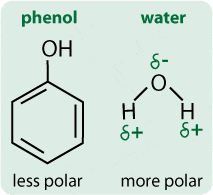Phenol extraction is a commonly used method for removing proteins from a DNA sample, e.g. to remove proteins from cell lysate during genomic DNA preparation. It’s commonly used, but not commonly understood.
If you want to know how it works so you can show off to all of your friends… read on.
The basic protocol
I’ll start with a quick outline of how the procedure is performed. First, a volume of phenol is added to the aqueous soup containing the proteins and the DNA to be purified.
Since phenol and water are immiscible, two phases form - a water (a.k.a. aqueous) phase and a phenol phase. Phenol is the more dense of the two liquids so it sits on the bottom.
The phases are then mixed thoroughly. This forces the phenol into the water layer where it forms an emulsion of droplets throughout. The proteins in the water phase are denatured and partition into the phenol, while the DNA stays in the water.
The mixture is then centrifuged and the phases separate. The DNA-containing water phase can now be pipetted off, and the phenol/protein solution is discarded. Commonly, the DNA is then de-salted and concentrated using ethanol precipitation.
First, a bit about solvents
To explain how the addition of phenol can separate DNA and proteins, we need to briefly touch on solvents. This is the chemistry bit… bear with me.
 A solvent is a substance, normally a liquid, that can dissolve other substances. Broadly, solvents can be classified according to their polarity, which depends on how extreme the spread of the electron density in the molecule is.
A solvent is a substance, normally a liquid, that can dissolve other substances. Broadly, solvents can be classified according to their polarity, which depends on how extreme the spread of the electron density in the molecule is.
Water is a very polar solvent because the oxygen atom is very electronegative so it “sucks” the electrons towards it and away from the hydrogens, creating a slight negative charge on the oxygen and a slight positive on the hydrogens. i.e. the charge is “polarised” within the molecule.
Phenol is a less polar molecule than water. Although it has a highly electronegative oxygen, this is counteracted by the phenyl ring, which is also very electronegative so there is no concentration of electron density around the oxygen. i.e. the charge is not so polarised in a phenol molecule.
DNA is most soluble in the water phase
So what does this have to do with the separation of DNA and protein?
Well in general, polar (charged) compounds dissolve best in polar solvents and non-polar molecules dissolve best in less polar or non-polar solvents.
DNA is a polar molecule due to the negative charges on it’s phosphate backbone, so it is very soluble in water and less so in phenol. This means that when the water(+DNA +protein) and phenol are mixed in the protocol, the DNA does not dissolve in the phenol, but remains in the water phase.
 The solubility of the proteins is flipped by phenol
The solubility of the proteins is flipped by phenol
But, proteins are a different story entirely.
As you know proteins are made up of long chains of amino acids. Each amino acid has it’s own characteristics, due to the nature of their side chains. Some, (e.g. phenylalanine, leucine, and tryptophan) are non-polar, because their side chains contain no charged entities. Conversely, amino acids with side chains containing charged entities (e.g. glutamate, lysine and histidine) are polar.
The polarity differences in the side chains are biologically important because they largely determine how peptides fold into functional proteins. Put simply, the chains fold so that as many as possible of the side chains that are less polar than the solvent are on the inside of the proteins (away from the solvent), while those that are of similar polarity to the solvent are arranged on the outside of the proteins (see panel 1 in the figure above). Another way to think about it is that polar side chains are hydrophilic, and non-polar are hydrophobic. The hydrophobic side chains hide on the inside, with the hydrophilic chains on the outside.
In the cell (and note, I am talking about cytoplasmic proteins here), the proteins are folded according to the influence of water as the solvent, but when the proteins are exposed to a less polar solvent, like phenol, their folding changes (see panel 2 in the figure).
Basically, the proteins flip inside-out. The less-polar residues, which hid inside the protein structures in water, now want to interact with the less-polar phenol so are forced to the outside. Conversely, some of the very polar residues may flip to the inside of the globular protein to be shielded from the unsuitable new solvent.
In short the proteins are permanently denatured by the new solvent environment provided by the phenol.
Whereas in water the polar residues on on the outside of the proteins made them soluble in water, the phenol-induced folding changes forced the phenol-favoring residues to outside so that the proteins are now more more soluble in phenol than in water.
And this is the basis of the separation. The phenol-soluble proteins partition to the phenol phase while, as discussed above, the water soluble, polar DNA molecules stay in the water phase (see panel 3 in the figure).
So that’s how phenol extraction works. If you have any questions, or corrections, be sure to let me know.
Courtesy: Nick, BitesizeBio
No comments:
Post a Comment